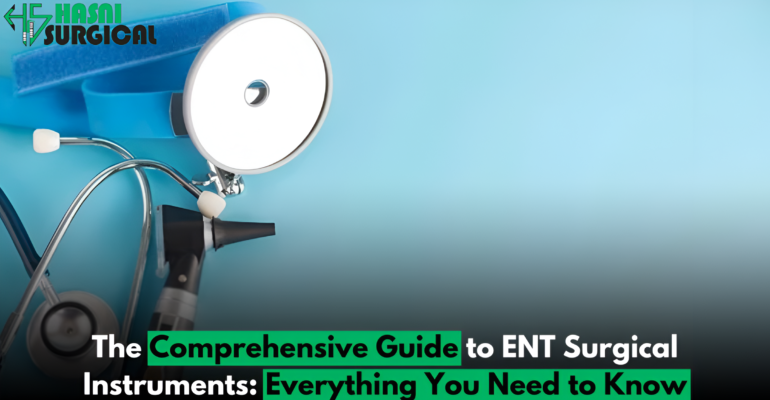The Comprehensive Guide to ENT Surgical Instruments: 6 Things You Need to Know
January 11, 2025 2025-01-11 7:11The Comprehensive Guide to ENT Surgical Instruments: 6 Things You Need to Know

The Comprehensive Guide to ENT Surgical Instruments: 6 Things You Need to Know
The surgeries for the ears, nose, and throat involve touching with skilled hands that are delicate through specialized instruments. It helps in curing conditions that plague the most sensitive and complex parts of the human anatomy.
No surgery can be performed without proper ENT surgical instruments; they ensure the best results, safety to the patient, and minimum work time for doctors. This guide discusses a whole range of ENT surgical instruments, grouped under various categories, and their usage, design, and purpose.
Guide to the Categories of ENT Surgical Instruments:

1. Ear Surgery Instruments
Ear procedures, such as tympanoplasty, mastoidectomy, and stapedectomy, necessitate the use of special instruments to manipulate structures like the eardrum and ossicles.
Key surgical instruments:
- Myringotomy knife: An instrument used for making incisions on the eardrum.
- Ear Speculum: It gives an unobstructed view of the ear canal.
- Rosen Needle: The best tool for delicate manipulations in ear surgery.
- Alligator Forceps: These are instruments used for picking up foreign bodies or tissue inside the ear canal.
- Micro Ear Suction Tubes Indication: Also aid in evacuating fluid or debris from the ear.

2. Nasal Surgery Instruments
Nasal surgeries, such as septoplasty, rhinoplasty, and sinus surgeries, demand carefulness to avoid complications and obtain functional and aesthetic results.
Important surgical instruments:
- Cottle Elevator: Helps elevate tissue during nasal surgeries.
- Freer Septum Elevator: Best suited for septoplasty procedures.
- Kerrison Rongeur: Removes bone or soft tissue during sinus surgeries.
- Nasal Speculum: Dilation of the nostrils to improve visualization.
- Killian Forceps: Used to grasp nasal tissue or polyps.

3. Throat Surgery Instruments
Throat surgeries, such as tonsillectomy, adenoidectomy, and laryngoscopy, require tools to navigate the intricate structures of the pharynx and larynx.
Key Instruments:
- Tonsil Snare: Helps in removal of tonsils with minimal blood loss.
- Adenoid Curette: Helps in removal of adenoid tissue in the nasopharynx.
- Laryngoscope: Helps in visualizing the larynx.
- Tongue Depressor: Used in holding the tongue down during examination.
- Bipolar Forceps: Helps in coagulation of tissue to prevent loss of blood.

4. Specialized ENT Surgical Instruments
Micro and Endoscopic ENT Surgery Tools
Advancements in minimally invasive surgery have made micro- and endoscopic tools indispensable. They allow for the most precise interventions by causing the least amount of disturbance to adjacent tissues.
- Endoscopes: Give a high-definition view of the ear, nose, or throat.
- Micro Scissors: For detailed tissue cutting in microsurgeries
- Micro forceps: Facilitate fine manipulations within tight spaces.
- Suction-Irrigation System: Promotes a clear surgical field in endoscopic procedures.

5. Selecting the Appropriate ENT Surgical Instrument
There are a few considerations while selecting ENT surgical instruments:
- Material Quality: Instruments manufactured from high-grade stainless steel make them more resistant to corrosion and durable.
- Ergonomics: Well-designed instruments lessen surgeon fatigue and ensure precision.
- Sterilization compatibility: Tools should withstand repeated sterilization without degrading.
- Manufacturer Reliability: Select such reliable manufacturers that have years of experience in producing top-notch ENT instruments, such as Hasni Surgical.

6. Maintenance Tips for ENT Instruments
- Immediate Cleaning: Instruments should be rinsed immediately after use to prevent residue buildup.
- Proper sterilization: Apply the appropriate sterilization technique for the various instruments.
- Routine Inspection: Regularly check for wear and tear to ensure functionality.
- Storage: Instruments should be kept in a clean, dry place to avoid corrosion.
Conclusion
ENT surgical instruments are the base of otolaryngology procedures. Maintaining quality instruments, keeping the instrument set updated and of excellent quality, and being sure it enhances precision for better surgical work while also achieving good outcomes will improve performance by medical professionals in the operating room.
Browse Hasni Surgical’s vast catalogue of reusable medical instruments designed to precision and durability for high-quality ENT instruments. Contact us today to find out how we can support your surgical needs.
